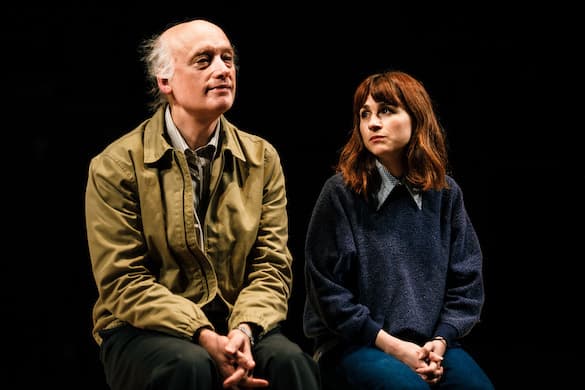Plenty of Funny Moments Here, but the Tragedy Is No Joke
In ‘The Best We Could (a family tragedy),’ Emily Feldman reveals her characters like pieces in a puzzle assembled over time, and their foibles are drawn with maturity and compassion.

The increasingly gaping divide between the world views of Baby Boomers and those of their post-Generation X children is often played for laughs these days, and certainly there are plenty of funny moments in “The Best We Could (a family tragedy),” Emily Feldman’s absorbing, precociously humane account of an aging man’s relationship with his 30-something daughter.
Ms. Feldman is around the same age as Ella, who accompanies her father, Lou, on a cross-country road trip, ostensibly for the purpose of adopting a new dog after his beloved pet dies. For roughly the first half of this one-act play, you may be lulled into thinking it’s yet another winking tale of family dysfunction viewed through the lens of generational conflict.
Yet the “tragedy” in the play’s title is no joke; the last 20 minutes of this production, directed with razor-like precision by Daniel Aukin, are as excruciating as any I’ve spent in a theater in recent memory. Not that the final blow comes out of the blue: Ms. Feldman reveals her characters like pieces in a puzzle assembled over time, and their foibles are drawn with the maturity and compassion that the main title suggests.
Some of those foibles are established early. A character identified in the text as Maps knocks down the fourth wall immediately; played by a tautly authoritative Maureen Sebastian, who also juggles a few smaller roles, she will serve as a guide for the audience and the others on stage, even directing the lighting designer. Maps introduces Ella as a woman who, after abandoning a string of creative and professional pursuits, is now teaching chair yoga while “working on an illustrated book about giving up on your dreams” — a tome that has already been dismissed by one publisher, we’ll later learn, as “an impenetrable Marxist screed.”
Lou’s life, in contrast, appears to have been a model of conformity. Married for nearly four decades to Peg, a retired event planner, he has spent most of that time employed as an investigator at a biomedical research institute. Since losing that job, though, he seems to have fallen into a funk; as played by the redoubtable Frank Wood, Lou paces the stage like a lost boy, voicing vague plans to contact old friends and land new opportunities.
The more fiery Peg — brought to crackling life by Constance Shulman, who gets some of Ms. Feldman’s most piquant lines — is devoted to her husband but frustrated by his malaise. Ella, played by a witty, measured Aya Cash, clearly adores Lou as well, but clashes with him on various issues that inevitably arise on their long journey. Gently pressed about her declining fertility, she retorts, “I don’t even have a partner. I don’t even have a dishwasher.”
However scrupulously Lou has been following what he perceives to be the rules for leading a successful, respectable life, he hasn’t noticed them shifting. As “The Best We Could” moves back and forth in time, shedding more light on these and other characters — key among them an old friend and colleague of Lou, played by a dry but warm Brian D. Coats, and a mysterious Zumba junkie played by Ms. Sebastian — Ms. Feldman examines how our fortunes and our choices, particularly the bad ones, can work synergistically.
We also see how Ella’s own rigid ideas of right and wrong can be challenged by human frailty — a tendency many of us only fully recognize when that human is someone near and dear to us. When another character tells Lou, late in the play, “I need to build a wall between my empathy and your culpability,” she could be rationalizing any number of grievances that have, justly or not, led to upended lives and careers in recent years.
That Ms. Feldman can summon and sustain empathy so deftly, without letting any of her characters off the hook, defies stereotypes applied to her age group (and younger artists) — and suggests that her own best lies ahead.

